Computer Networks (CS425)
Instructor: Dr. Dheeraj Sanghi
Prev|
Next|
Index
Multiplexing
When two communicating nodes are connected through a media, it generally happens that bandwidth of media is several
times greater than that of the communicating nodes. Transfer of a single signal at a time is both slow and expensive.
The whole capacity of the link is not being utilized in this case. This link can be further exploited by sending
several signals combined into one. This combining of signals into one is called multiplexing.
- Frequency Division Multiplexing (FDM): This is possible in the case where transmission media has a bandwidth
than the required bandwidth of signals to be transmitted. A number of signals can be transmitted at the same time.
Each source is allotted a frequency range in which it can transfer it's signals, and a suitable frequency gap is
given between two adjescent signals to avoid overlapping. This is type of multiplexing is commonly seen in the cable
TV networks.
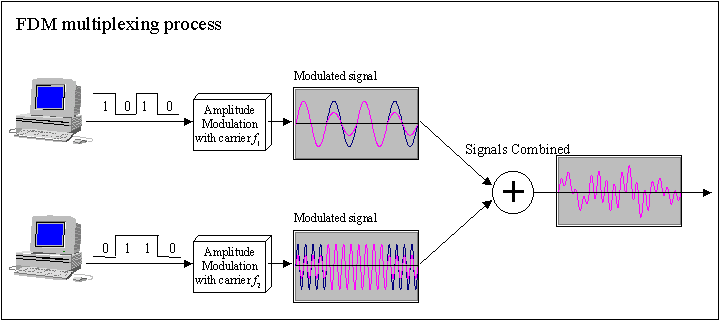
- Time Division Multiplexing (TDM): This is possible when data transmission rate of the media is much higher
than that of the data rate of the source. Multiple signals can be transmitted if each signal is allowed to be
transmitted for a definite amount of time. These time slots are so small that all transmissions appear to be in parallel.
- Synchronous TDM: Time slots are preassigned and are fixed. Each source is given it's time slot at every
turn due to it. This turn may be once per cycle, or several turns per cycle ,if it has a high data transfer rate, or
may be once in a no. of cycles if it is slow. This slot is given even if the source is not ready with data. So this
slot is transmitted empty.
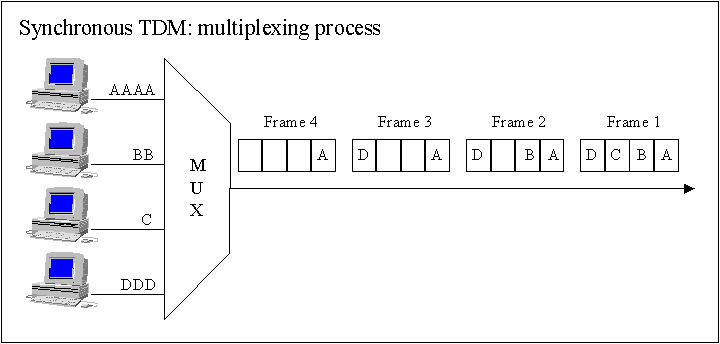
- Asynchronous TDM: In this method, slots are not fixed. They are allotted dynamically depending on speed
of sources, and whether they are ready for transmission.
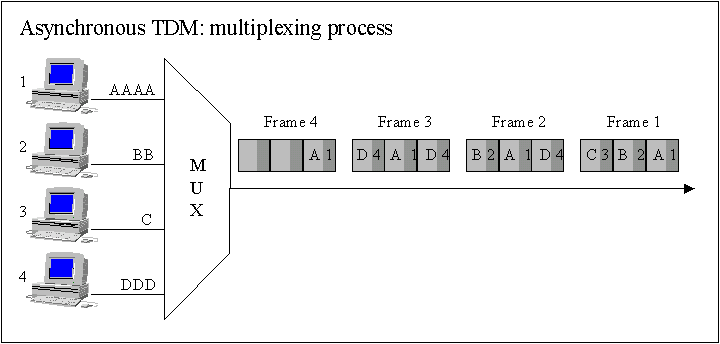
Network Topologies
A network topology is the basic design of a computer network. It is very much like a map of a road. It details how key
network components such as nodes and links are interconnected. A network's topology is comparable to the blueprints of
a new home in which components such as the electrical system, heating and air conditioning system, and plumbing are
integrated into the overall design.
Taken from the Greek work "Topos" meaning "Place," Topology, in relation to networking, describes the configuration of
the network; including the location of the workstations and wiring connections. Basically it provides a definition of
the components of a Local Area Network (LAN). A topology, which is a pattern of interconnections among nodes,
influences a network's cost and performance.
There are three primary types of network topologies which refer to the physical and logical layout of the Network
cabling. They are:
- Star Topology: All devices connected with a Star setup communicate through a central Hub by cable segments.
Signals are transmitted and received through the Hub. It is the simplest and the oldest and all the telephone switches
are based on this. In a star topology, each network device has a home run of cabling back to a network hub, giving each
device a separate connection to the network. So, there can be multiple connections in parallel.

Advantages
- Network administration and error detection is easier because problem is isolated to central node
- Networks runs even if one host fails
- Expansion becomes easier and scalability of the network increases
- More suited for larger networks
Disadvantages
- Broadcasting and multicasting is not easy because some extra functionality needs to be provided to the central hub
- If the central node fails, the whole network goes down; thus making the switch some kind of a bottleneck
- Installation costs are high because each node needs to be connected to the central switch
- Bus Topology: The simplest and one of the most common of all topologies, Bus consists of a single cable,
called a Backbone, that connects all workstations on the network using a single line. All transmissions must pass
through each of the connected devices to complete the desired request. Each workstation has its own individual signal
that identifies it and allows for the requested data to be returned to the correct originator. In the Bus Network,
messages are sent in both directions from a single point and are read by the node (computer or peripheral on the
network) identified by the code with the message. Most Local Area Networks (LANs) are Bus Networks because the
network will continue to function even if one computer is down. This topology works equally well for either peer to
peer or client server.

The purpose of the terminators at either end of the network is to stop the signal being reflected back.
Advantages
- Broadcasting and multicasting is much simpler
- Network is redundant in the sense that failure of one node doesn't effect the network. The other part may still function properly
- Least expensive since less amount of cabling is required and no network switches are required
- Good for smaller networks not requiring higher speeds
Disadvantages
- Trouble shooting and error detection becomes a problem because, logically, all nodes are equal
- Less secure because sniffing is easier
- Limited in size and speed
- Ring Topology: All the nodes in a Ring Network are connected in a closed circle of cable. Messages that are
transmitted travel around the ring until they reach the computer that they are addressed to, the signal being refreshed
by each node. In a ring topology, the network signal is passed through each network card of each device and passed on
to the next device. Each device processes and retransmits the signal, so it is capable of supporting many devices in a
somewhat slow but very orderly fashion. There is a very nice feature that everybody gets a chance to send a packet and
it is guaranteed that every node gets to send a packet in a finite amount of time.

Advantages
- Broadcasting and multicasting is simple since you just need to send out one message
- Less expensive since less cable footage is required
- It is guaranteed that each host will be able to transmit within a finite time interval
- Very orderly network where every device has access to the token and the opportunity to transmit
- Performs better than a star network under heavy network load
Disadvantages
- Failure of one node brings the whole network down
- Error detection and network administration becomes difficult
- Moves, adds and changes of devices can effect the network
- It is slower than star topology under normal load
Generally, a BUS architecture is preferred over the other topologies - ofcourse, this is a very subjective opinion and
the final design depends on the requirements of the network more than anything else. Lately, most networks are shifting
towards the STAR topology. Ideally we would like to design networks, which physically resemble the STAR topology, but
behave like BUS or RING topology.
Data Link Layer
Data link layer can be characterized by two types of layers:
- Medium Access Layer (MAL)
- Logical Link Layer
Aloha Protocols
History
The Aloha protocol was designed as part of a project at the University of Hawaii. It provided data transmission
between computers on several of the Hawaiian Islands using radio transmissions.
- Communications was typically between remote stations and a central sited named Menehune or vice versa.
- All message to the Menehune were sent using the same frequency.
- When it received a message intact, the Menehune would broadcast an ack on a distinct outgoing frequency.
- The outgoing frequency was also used for messages from the central site to remote computers.
- All stations listened for message on this second frequency.
Pure Aloha
Pure Aloha is an unslotted, fully-decentralized protocol. It is extremely simple and trivial to
implement. The ground rule is - "when you want to talk, just talk!". So, a node which wants to transmits, will go
ahead and send the packet on its broadcast channel, with no consideration whatsoever as to anybody else is transmitting
or not.
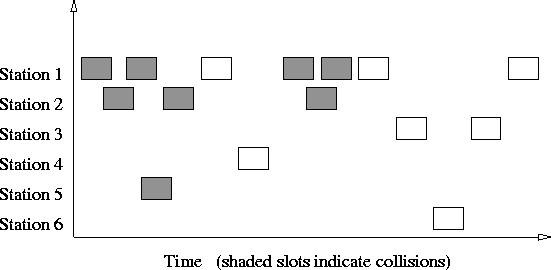
One serious drawback here is that, you dont know whether what you are sending has been received properly or not (so as
to say, "whether you've been heard and understood?"). To resolve this, in Pure Aloha, when one node finishes speaking,
it expects an acknowledgement in a finite amount of time - otherwise it simply retransmits the data. This scheme works
well in small networks where the load is not high. But in large, load intensive networks where many nodes may want to
transmit at the same time, this scheme fails miserably. This led to the development of Slotted Aloha.
Slotted Aloha
This is quite similar to Pure Aloha, differing only in the way transmissions take place. Instead of transmitting right
at demand time, the sender waits for some time. This delay is specified as follows - the timeline is divided into
equal slots and then it is required that transmission should take place only at slot boundaries. To be more precise,
the slotted-Aloha makes the following assumptions:
- All frames consist of exactly L bits.
- Time is divided into slots of size L/R seconds (i.e., a slot equals the time to transmit one frame).
- Nodes start to transmit frames only at the beginnings of slots.
- The nodes are synchronized so that each node knows when the slots begin.
- If two or more frames collide in a slot, then all the nodes detect the collision event before the slot ends.
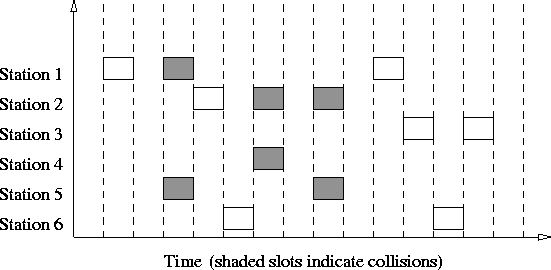
In this way, the number of collisions that can possibly take place is reduced by a huge margin. And hence, the
performance become much better compared to Pure Aloha. collisions may only take place with nodes that are ready to
speak at the same time. But nevertheless, this is a substantial reduction.
Carrier Sense Mutiple Access Protocols
In both slotted and pure ALOHA, a node's decision to transmit is made independently of the activity of the other nodes
attached to the broadcast channel. In particular, a node neither pays attention to whether another node happens to be
transmitting when it begins to transmit, nor stops transmitting if another node begins to interfere with its
transmission. As humans, we have human protocols that allow allows us to not only behave with more civility, but also
to decrease the amount of time spent "colliding" with each other in conversation and consequently increasing the amount
of data we exchange in our conversations. Specifically, there are two important rules for polite human conversation:
- Listen before speaking: If someone else is speaking, wait until they are done. In the networking world,
this is termed carrier sensing - a node listens to the channel before transmitting. If a frame from another node is
currently being transmitted into the channel, a node then waits ("backs off") a random amount of time and then again
senses the channel. If the channel is sensed to be idle, the node then begins frame transmission. Otherwise, the node
waits another random amount of time and repeats this process.
- If someone else begins talking at the same time, stop talking. In the networking world, this is termed
collision detection - a transmitting node listens to the channel while it is transmitting. If it detects that another
node is transmitting an interfering frame, it stops transmitting and uses some protocol to determine when it should
next attempt to transmit.
It is evident that the end-to-end channel propagation delay of a broadcast channel - the time it takes for a signal to
propagate from one of the the channel to another - will play a crucial role in determining its performance. The longer
this propagation delay, the larger the chance that a carrier-sensing node is not yet able to sense a transmission that
has already begun at another node in the network.
CSMA- Carrier Sense Multiple Access
This is the simplest version CSMA protocol as described above. It does not specify any collision detection or handling.
So collisions might and WILL occur and clearly then, this is not a very good protocol for large, load intensive
networks.
So, we need an improvement over CSMA - this led to the development of CSMA/CD.
CSMA/CD- CSMA with Collision Detection
In this protocol, while transmitting the data, the sender simultaneously tries to receive it. So, as soon as it
detects a collission (it doesn't receive its own data) it stops transmitting. Thereafter, the node waits for some time
interval before attempting to transmit again. Simply put, "listen while you talk". But, how long should one wait
for the carrier to be freed? There are three schemes to handle this:
- 1-Persistent: In this scheme, transmission proceeds immediately if the carrier is idle. However, if the carrier is
busy, then sender continues to sense the carrier until it becomes idle. The main problem here is that, if more than
one transmitters are ready to send, a collision is GUARANTEED!!
- Non-Persistent: In this scheme, the broadcast channel is not monitored continuously. The sender polls it at
random time intervals and transmits whenever the carrier is idle. This decreases the probability of collisions.
But, it is not efficient in a low load situation, where number of collisions are anyway small. The problems it entails
are:
- If back-off time is too long, the idle time of carrier is wasted in some sense
- It may result in long access delays
- p-Persistent: Even if a sender finds the carrier to be idle, it uses a probabilistic distribution to
determine whether to transmit or not. Put simply, "toss a coin to decide". If the carrier is idle, then transmission
takes place with a probability p and the sender waits with a probability 1-p. This scheme is a good trade off between
the Non-persistent and 1-persistent schemes. So, for low load situations, p is high (example: 1-persistent); and for
high load situations, p may be lower. Clearly, the value of p plays an important role in determining the performance
of this protocol. Also the same p is likely to provide different performance at different loads.
CSMA/CD doesn't work in some wireless scenarios called "hidden node" problems. Consider a situation, where there are 3
nodes - A, B and C communicating with each other using a wireless protocol. Morover, B can communicate with both A and
C, but A and C lie outside each other's range and hence can't communicate directly with each other. Now, suppose both
A and C want to communicate with B simultaneously. They both will sense the carrier to be idle and hence will begin
transmission, and even if there is a collision, neither A nor C will ever detect it. B on the other hand will receive
2 packets at the same time and might not be able to understand either of them. To get around this problem, a better
version called CSMA/CA was developed, specially for wireless applications.
Image References:
- http://williams.comp.ncat.edu/Networks/multip10.gif
- http://williams.comp.ncat.edu/Networks/multip5.gif
- http://williams.comp.ncat.edu/Networks/multip13.gif
- http://www.e-networks.org/images/startopology.gif
- http://www.delmar.edu/Courses/CIS306/Primer/primf05.gif
- http://www.e-networks.org/images/ringtopology.gif
- http://www.laynetworks.com/images/aloha14.gif
- http://www.laynetworks.com/images/aloha15.gif
back to top
Prev| Next |
Index







